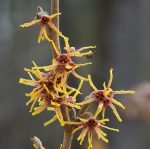 Ozark witch hazel is a deciduous flowering shrub or small tree native to the Ozark Plateau from southern Missouri through northwestern Arkansas east to Oklahoma where it grows in moist areas and can form large colonies. It is a member of the witch hazel family, Hamamelidaceae, that also includes loropetalum, fothergill, and Persian ironwood. Plants grow up to 10′ tall and have zig zag twigs and thick, ovate to rounded leaves up to 4″ long with deeply crenate margins, conspicuous sunken veins, and a short petiole. The leaves emerge medium to dark green but become golden-yellow in the fall although some cultivars turn orange, red, and purple. In mid to late winter before the foliage emerges, fragrant flowers appear in axillary clusters. The flowers range in color from pale yellow to orange and red-orange, and have four, narrow, ribbon-like petals that are 1/3″ long and roll up on cold days, roll out on warm ones. The fruit is a 2-valved capsule that is produced in late summer and persists into winter. Ozark witch hazel provides very welcome interest in winter and is a good choice for a shrub border, screen, hedge, woodland or winter garden. Flowers can be forced for the vase. The genus name, Hamamelis, comes from the Greek words ᾰ̔́μᾰ (háma), meaning simultaneously, and μῆλον (mēlon) meaning fruit, and refers to the fact that some members of the genus produce flowers while the previous year’s fruit ripen. The specific epithet, vernalis, is the Latin word meaning of spring and refers to the early bloom time.
Ozark witch hazel is a deciduous flowering shrub or small tree native to the Ozark Plateau from southern Missouri through northwestern Arkansas east to Oklahoma where it grows in moist areas and can form large colonies. It is a member of the witch hazel family, Hamamelidaceae, that also includes loropetalum, fothergill, and Persian ironwood. Plants grow up to 10′ tall and have zig zag twigs and thick, ovate to rounded leaves up to 4″ long with deeply crenate margins, conspicuous sunken veins, and a short petiole. The leaves emerge medium to dark green but become golden-yellow in the fall although some cultivars turn orange, red, and purple. In mid to late winter before the foliage emerges, fragrant flowers appear in axillary clusters. The flowers range in color from pale yellow to orange and red-orange, and have four, narrow, ribbon-like petals that are 1/3″ long and roll up on cold days, roll out on warm ones. The fruit is a 2-valved capsule that is produced in late summer and persists into winter. Ozark witch hazel provides very welcome interest in winter and is a good choice for a shrub border, screen, hedge, woodland or winter garden. Flowers can be forced for the vase. The genus name, Hamamelis, comes from the Greek words ᾰ̔́μᾰ (háma), meaning simultaneously, and μῆλον (mēlon) meaning fruit, and refers to the fact that some members of the genus produce flowers while the previous year’s fruit ripen. The specific epithet, vernalis, is the Latin word meaning of spring and refers to the early bloom time.
Type: Deciduous flowering shrub or small tree
Outstanding Feature:
Form: Vase-shaped in youth becoming rounded with maturity
Growth Rate: Slow
Bloom: Pale yellow to orange or orange-red fragrant flowers with 4 petals that roll up in the cold and out in the warmth, from mid to late winter
Size: 6-10′ H 8-15′ W
Light: Full sun to partial shade
Soil: Average, medium moist, well-drained, acidic; tolerates clay soil if well drained.
Hardiness: Zones 4-8
Care: Remove suckers to restrict spread; prune after flowering to control size and shape
Pests and Diseases: Generally healthy but susceptible to rots, leaf spot, powdery mildew, leaf gall aphids, leafminer, leafroller, scale, weevils, and damage by caterpillars and Japanese beetles.
Propagation: Seed, rooted stem cuttings
Outstanding Selections:’Sandra’ (may have purplish new growth, larger flowers, stronger autumn coloration)
Photo Credit: Wikipedia